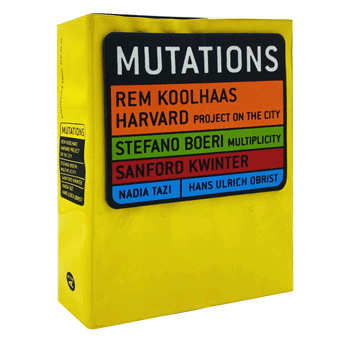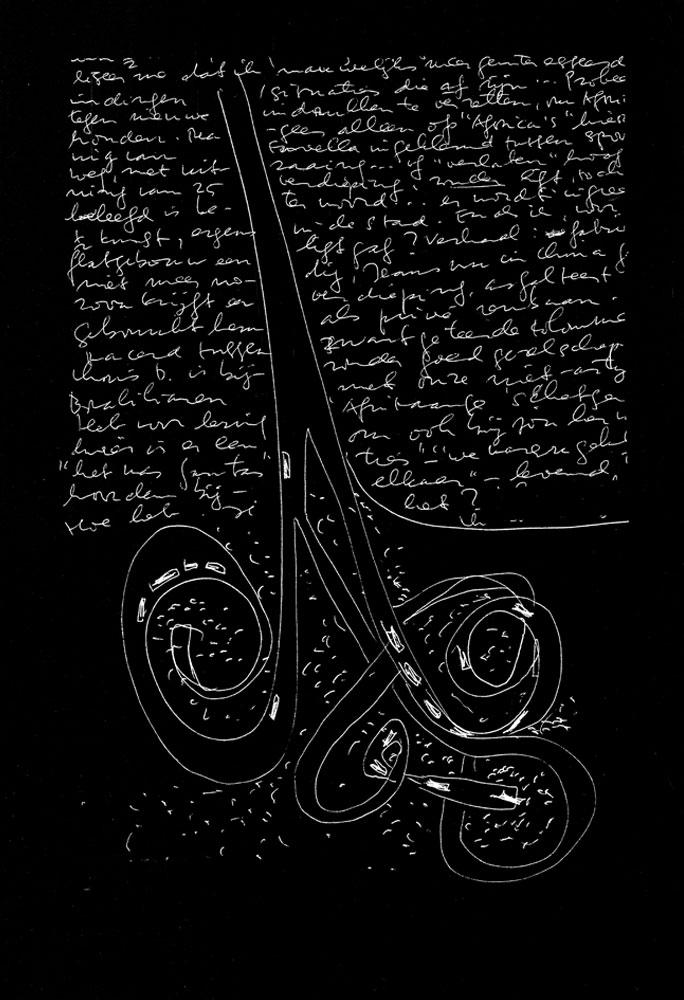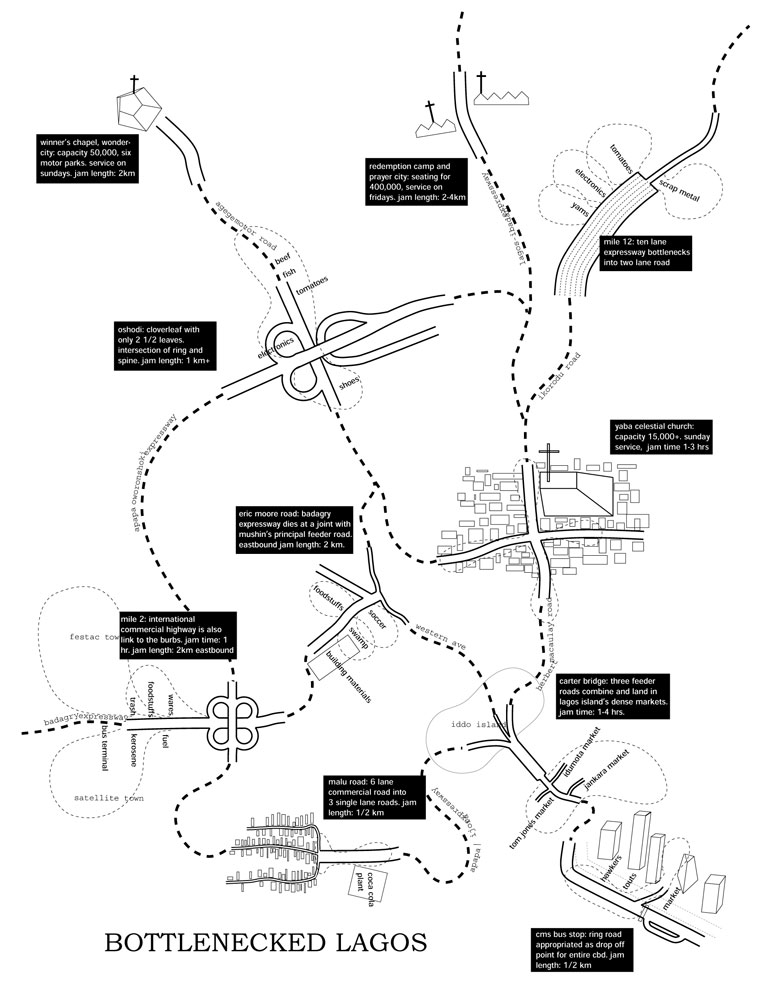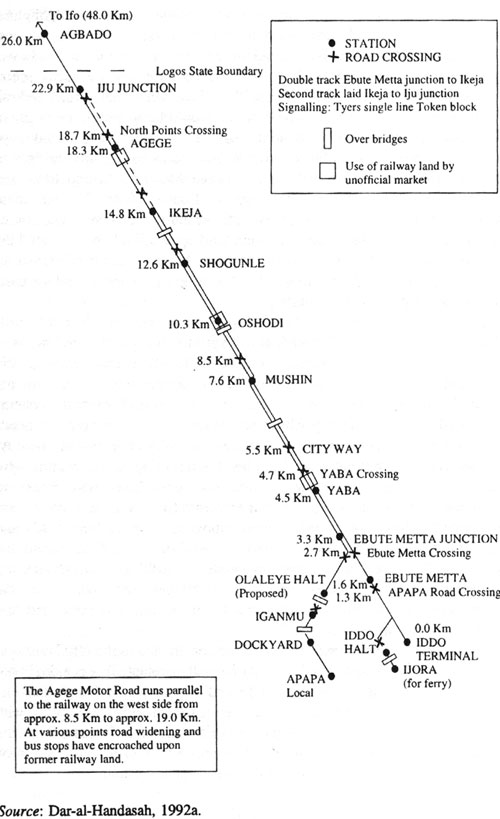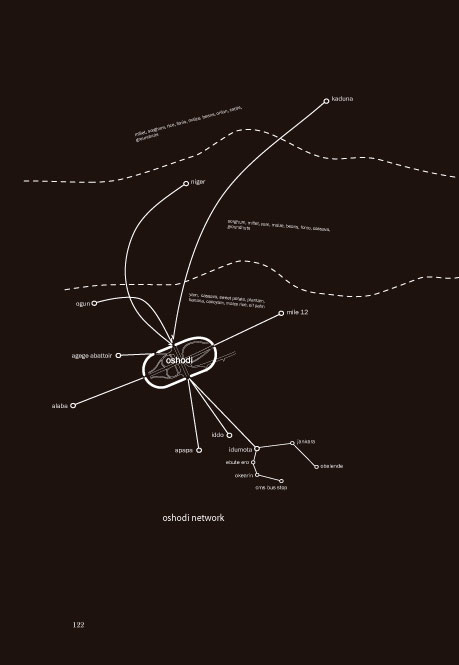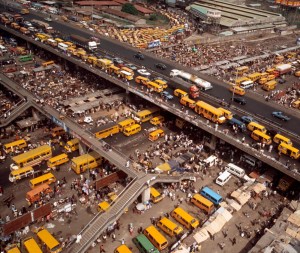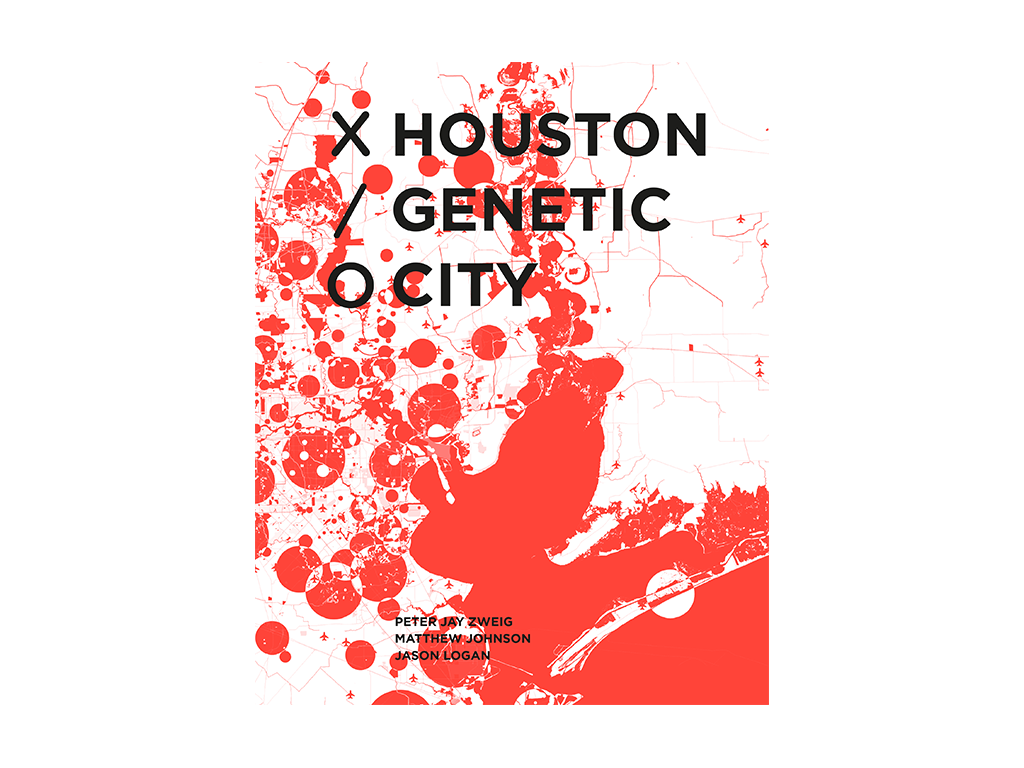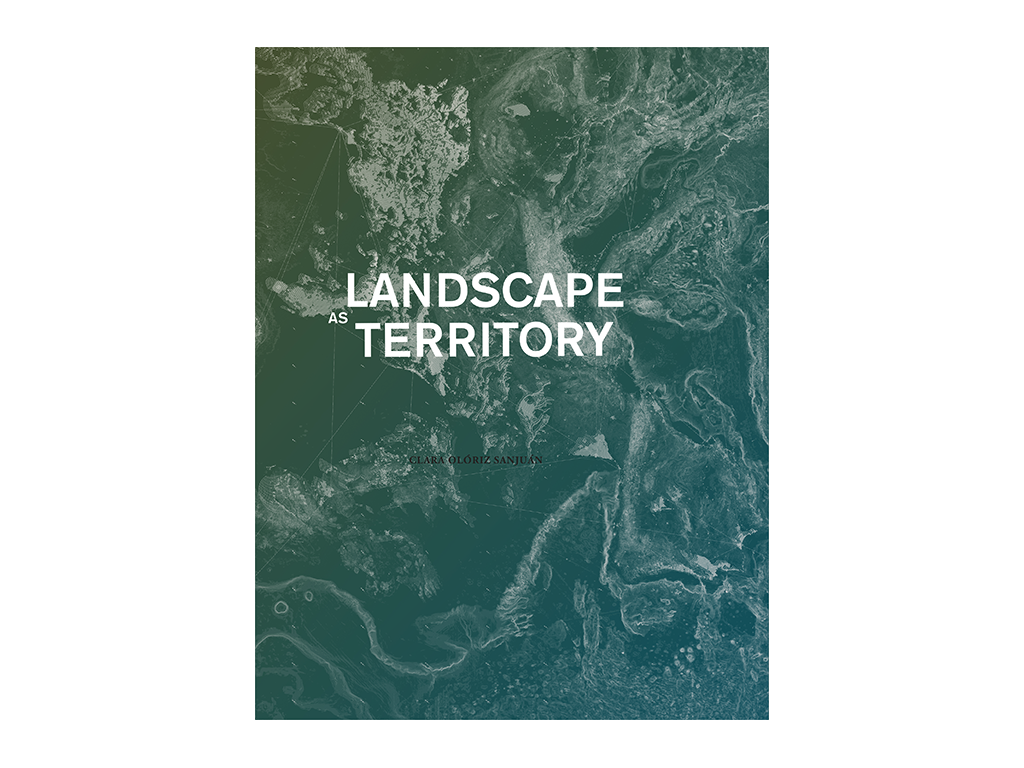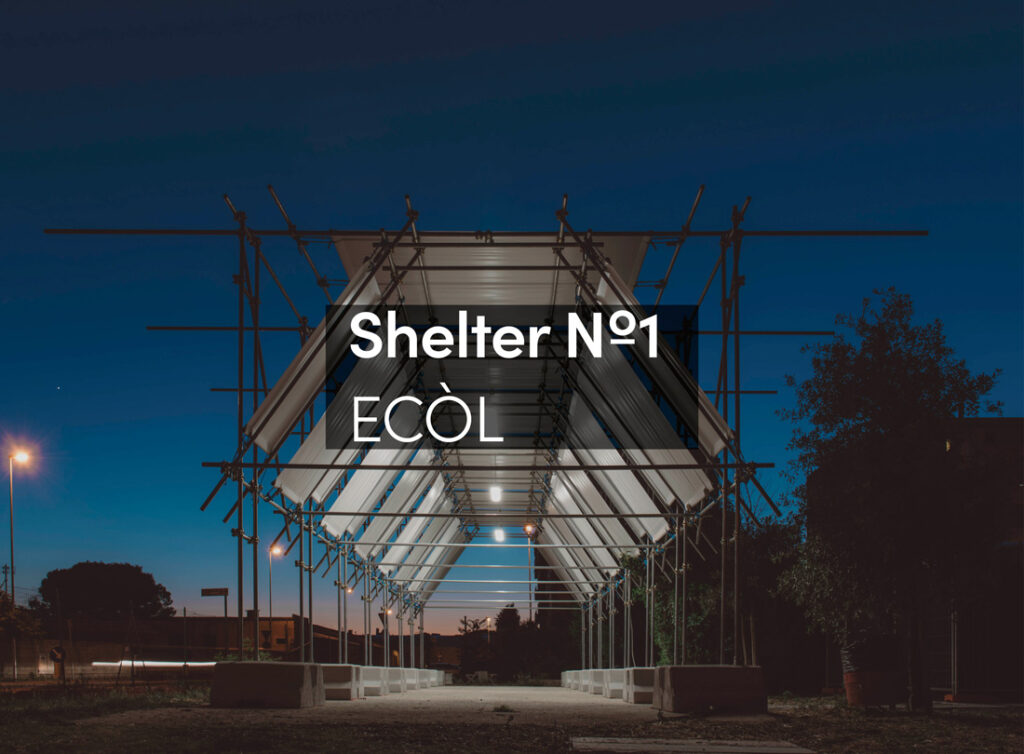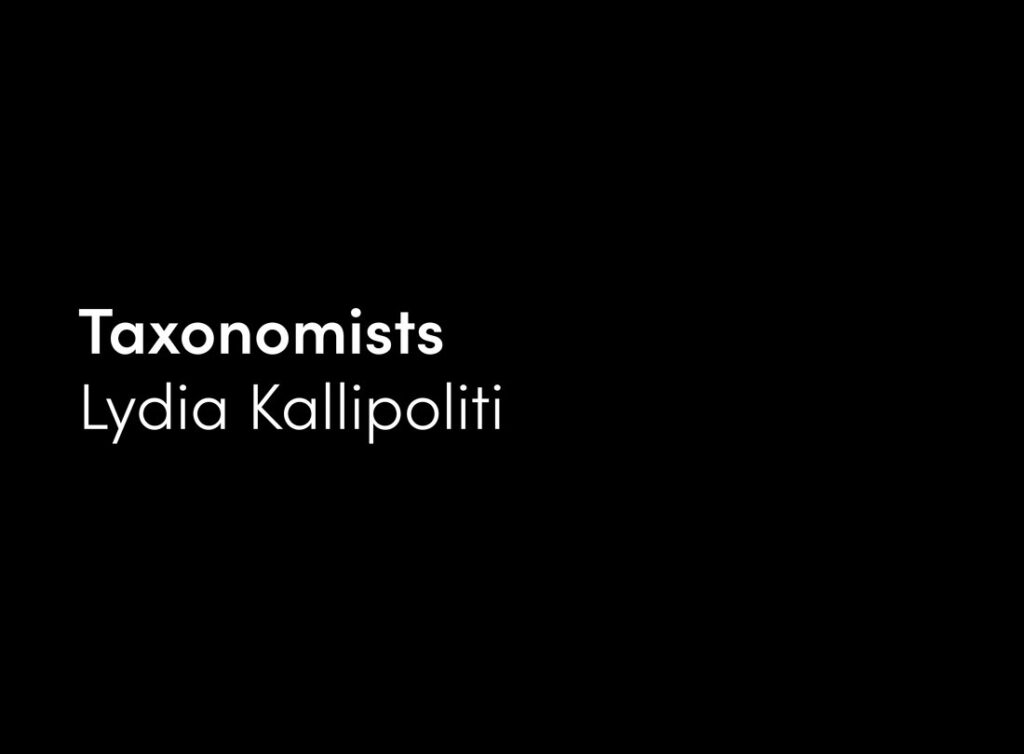The fundamental conundrum of Lagos, considered as both paradigm and pathological extreme of the West African city, is its continued existence and productivity in spite of a near-complete absence of those infrastructures, systems, organizations, and amenities that define the word “city” in terms of Western planning methodology. Lagos, as an icon of West African urbanity, inverts every essential characteristic of the so-called modern city. Yet, it is still—for lack of a better word—a city; and one that works.
Rapidly expanding, transforming, and perfecting, the Lagos urban condition allows for the survival of up to fifteen million people.
Anguish over its shortcomings in traditional urban systems obscures the reasons for the continued, exuberant existence of Lagos and other megacities like it. These shortcomings have generated ingenious, critical alternative systems, which demand a redefinition of ideas such as carrying capacity, stability, and even order, canonical concepts in the fields of urban planning and related social sciences. The operation of the Lagos megalopolis illustrates the large-scale efficacy of systems and agents considered marginal, liminal, informal, or illegal according to traditional understandings of the city.
This project is as much a study of Lagos as it is a study of more radical possibilities in the discipline of urban planning, and a proposal of new ways to examine the modern city. While the conditions identified in Lagos are extreme cases, such extremity is generally a very rational response to a dysfunctional scenario.
The material logic of Lagos is convincing.
We are resisting the notion that Lagos represents an African city en route to becoming modern. Or, in a more politically correct idiom, that it is becoming modern in a valid, “African” way. Rather, we think it possible to argue that Lagos represents a developed, extreme, paradigmatic case-study of a city at the forefront of globalizing modernity.
This is to say that Lagos is not catching up with us. Rather, we may be catching up with Lagos.
The African city forces the reconceptualization of the city itself. The fact that many of the trends of modern, Western cities can be seen in hyperbolic guise in Lagos suggests that to write about the African city is to write about the terminal condition of Chicago, London, or Los Angeles. It is to examine the city elsewhere, in the developing world. It is to reconsider the modern city and to suggest a paradigm for its future.
In short, we would argue, it is to do away with the inherited notion of “city” once and for all.
Property
“Africans are constantly rearranging their social, economic, religious, and domestic lives in the process of consuming more than they produce… Shifting designations creates a seemingly permanent state of political ambiguity.”[1]
Despite the presence of both land-use data collected at the regional scale and the national grid system, a boundary for Lagos has never been drawn or agreed upon. The lack of clear spatial boundaries has left open and unresolved the question of where authority over the land areas resides, leading to disputes in legal and political administration and the practice of census enumeration. Lagos Island is the only area in the city which maintained a fixed boundary between 1911 and 1962, at 155 square miles (while its population, according to written sources, multiplied threefold).[2] For censuses taken between 1901 and 1962, the national area covered increased from 18 square miles to 27.22 square miles. The discipline of geography has failed to grasp the single fact that the nature of accuracy and measure in Lagos is negotiable. Geography and the settlement of property in Lagos cannot be assessed and measured according to the fixed definitions of the census and the aerial photograph. Property lines are continually being reassessed and renegotiated in accordance with intersecting land laws, taxes, claims, and interests. This structural skein camouflages its ordering system, but recognizes that one’s right to reside and work in the city is flexible and mutable. The negotiability of property lines means that there is no fixed typology in Lagos. Different types may be introduced or develop, but they are invariably subject to reassessment and reconfiguration.
Plot
“The unit of property in Lagos derives from the Yoruba compound.
The compound is a collective property and consists of an assembly of dwellings arranged in physical proximity. It is not strictly a typology, representing instead a loosely bounded space wherein a group of interests coexist side by side and in agreement. Its collective ownership as understood by customary law was hence not communal in the sense of being communally built, managed, and used. Individual rights were protected, and once an individual’s land had been settled and built on it was ‘divested’ of its communal use. Thus, under customary law, land could be transferable as an individual saw fit.” [3]
Despite this original flexibility, the compound has urbanized in Lagos as a property bounded by a perimeter wall and arranged around a courtyard and a communal alley. The compound develops through provisional occupation within a series of boundaries, or as the proliferation of a single-cell compound. As finances, means, and labor permit, the compound develops incrementally in a variety of ways. The residential base is often supported by small-scale businesses that operate adjacent to or in front of the dwelling, the profits or materials of which are gradually transferred to residential additions and renovations. The physical result is a high heterogeneity of use and function at the scale of the compound, homogeneous and porous space at the scale of the neighborhood.
The compound has modernized into a lucrative form of rental property.
8’ x 10’ rooms can easily be built to accommodate a family or a few people. Due to increased wealth and a new desire for individuality, the fission of the single cell now contributes to a process of compounding. Compounding occurs as 1) the construction of new rooms, and 2) the making of new surfaces, vertical or horizontal planes, gratings, fences, and metal sheets in ever more incremental layers. Compounding thus increases the amount of building program, as new rooms collect more rent and new surfaces support new businesses or functions. Like fission in physics, this process diversifies the compound programmatically, minimizes exterior space, and densifies existing spaces. Compounding demands a constant reassessment of urban and property boundary conditions and of socially constructed space.
Line
If the difficulty involved in establishing property led to its physical delimitation by walls, increased crime has transformed the property line into a means to exclude outsiders and to enforce and police one’s property.
This phenomenon is not limited to the wealthy areas normally targeted for crime, but occurs across the socioeconomic spectrum of real estate, from Ikoyi, Mushin, to Surulere. Though these areas were built according to different spatial typologies, they have been homogenized by their shared physical continuity, leveling the city into one psychic environment.
The wall is typically constructed out of CMU blocks, barbed wire, shards of glass and pebbles. A security gate is used to cross its threshold. Not only individual plots are walled this way; streets and districts policed by area boys and local vigilante groups, or neighborhood security are gated off with secure checkpoints. The construction of walls and security gates throughout the city has sparked an entire industry: steel reinforcing bars are regularly used to construct gates and entry doors, while architecturally designed gates are sought after by wealthier home owners.
The property line, originally a conceptual and abstract legal division designed to divide, enclose, and exclude, has materialized into a vertical wall whose surface has become an attractor for use, contamination, and the establishment of new economies. The wall has come to be taken for granted as an infrastructure that supports and serves a host of economies and small-scale industries. The wall itself can be used as the support for carpets, or security gates; in conjunction with a drain, it forms a thickened swath of space between the plot/compound and the street. This space is occupied by vulcanizers, petty traders, and can even accommodate sleeping in its width. The wall can also become a three-dimensional barrier, with a depth of 3 to 4 feet, that can be used as a marketable space.
Wall
The explosive growth that Lagos has witnessed in the last two decades—the population rises by an estimated 1,000/day—has assigned to the wall a new challenge. Today the wall is a machine for guarding land against occupation by the poor, the masses. It has become more a way of controlling surface than a mechanism against violence.
In Lagos, public space is continuously being occupied in new ways. Pavements have become crowded with hawkers, food merchants, mechanics, tailors, hairdressers, and all kinds of entrepreneurs. People jostle anarchically for turf, while “life” seems to thrive in the congestion of the streets. It is not clear which comes first: the rather extravagant and perhaps greedy delimiting of land in order to exclude and construct one’s own interior “world,” or the density of Lagos street life.
The interior that the wall defines does not necessarily remain static. Compounds regenerate and occasionally reinvent themselves, but, as with the large tracts of walled-in land that abound in Lagos, re-emerge as suburbia. In Lagos, suburbia is not confined to the periphery of the city, as is often the norm; it implodes in the city.
Is Lagos staged? Could it be that Lagos’s urbanity is artificially induced, rather ironically by the same forces that seek to diffuse it? Could it be that Lagos’s highly urban street life owes its existence to an implosion of suburbia?
Taxable Occupation of Land
The lack of clear zoning for industrial uses beyond the compounds of the multinational companies, and the incessant compounding of the entire city, has pushed the labor market to occupy the boundaries of private property and urban infrastructure. Road embankments, the underside of flyovers, railway tracks, and the city’s multiple shorelines have been colonized by a host of secondary industries and services—cement block factories, vulcanizers, roadside mechanics, hairdressers, roadside markets, and so on. This lining of the road system, most evident in the filling of the circular voids of cloverleaves, demonstrates the basics of space-planning: highway columns are used as spatial dividers, foundation pads as workable surfaces, and open areas serve for the markets or the collection and storage of materials. The undersides of flyovers are used for a range of purposes from industry, to storage, to car parks which can be conveniently fenced off between road columns. These land pieces belong either to the federal military government of Nigeria or to state government. This type of territorialization of space represents a temporary but legal occupation of land without ownership, a general lining of the urban fabric.
Near Jankara, Lagos’s largest market, four cloverleaves have been taken over as a recycling exchange. The recycling market has been located on the land since the 1960s, except for temporarily displacement by the Federal government during the construction of the highway (1973-78); the government has respected its land rights in exchange for a tax. The market has adapted the new highway infrastructure to its highest use potential. The order of the highway is in line with the production processes that take place there: small assembly operations take place beneath the flyover, where groups of young men assemble lanterns, cooking pots, and other metal wares. Others work as scavengers throughout the city, collecting scrap metal and plastics and assorting them into material piles. Storage and warehousing of these scraps takes place in the open area of the interchange. From scrap collection to sorting to design to assembly to re-sale, the entire chain of commodity production occurs within the highway interchange. The Jankara interchange services various corporations—Universal Steel is a regular purchaser of scrap metal, and major plastic manufacturers are also regular customers—suggesting that the transactions between lower and upper levels of the economy are converging on temporarily settled federal land. In fact, the gradual institutionalization of facilities such as Jankara suggests that the urbanization of capital in Lagos follows a different and more efficient logic than that of the redundant and inefficient highway construction.
Bottlenecked
The terms “go-slow” and “no-go” are part of a popular lexicon replete with nomenclature that expands the scope of traffic and movement to the level of urban consciousness. Go-slow describes the ubiquitous traffic jam: lulled in congestion, captive to the road’s breadth, and thriving with entrepreneurial activity. The go-slow is a transient condition, swelling diurnally with the usual peaks of urban movement. The no-go, on the other hand, is less a condition than a place. Defined by failed planning, bankrupted initiative, regular banditry, or physical collapse, the no-go stalls circulation in a space of maximum vulnerability. As such, the incomplete road or constricted intersection is in a way recuperated, becoming controllable—and extremely valuable—real estate. Jam-space, the totally negotiable, usually illegal and hugely productive space of the traffic jam, is not something to fix, solve, or even rationalize. Jam-space cannot be controlled or short-circuited, only bypassed. Rampant entrepreneurialism charges the bottleneck’s enormous physical friction with an even greater social traction.
As roads jam, their traffic spills into surrounding areas, expanding motorable terrain by default. The road hemorrhages at points of maximum inutility, subjecting neighboring communities and adjacent landscapes to the perils and opportunities of dispersed road traffic. Bottlenecks encourage detouring, turning “neighborhoods”—the white and gray space on the map between thickly drawn expressways—into an infinity of potential routes. Any road can be a feeder road, a collector, or an arterial. The detour is an inverse of positive proximity theory: rather than relying on proximity to fixed infrastructure for residual economic benefits, the detour redirects the infrastructure’s patrons to under-served areas. Jams and detours allow more of the city to be accessed more of the time.
Groups normally neglected by road traffic sometimes take advantage of the detour. Area boys, for example, purposefully destroy road surfaces to redirect road traffic into “ambush areas” or under-patronized commercial districts. In 1996, the 600 km Onitsha/Owerri road East of Lagos “caved in on several spots, making motorists detour in selected places, driving through farmlands and remote villages, crisscrossing abandoned terrain to reconnect to the highway. Many lives were lost in the process, vehicles endangered and many lost their way in far flung communities. Drivers drifted across the landscape like in the olden days.”[4] Lagos’s detours are usually subtle, sometimes dramatic, but never merely coincidental. Sometimes the detour is a self-administered flood that forces people off an expressway and into a neighborhood. Sometimes the diversion might be a roadway fire. At other times it might be coded as an arrangement between drivers and distributors, whereby the drivers stop in traffic so that jammed passenger cars can be subjected to roadway hawkers.
Lagos’s slowness has hardened. The expressways, originally dumped on the city to bind disparate destinations and origins, are now almost completely unrecognizable to the planner’s eye. On a map they still look like they organize the city. The view from above seems to make sense—“the city is interconnected.” But at each of the plan’s intersections this omniscience collapses. The Lagos “street” is inadequately described by throwaway terms like “channel,” “communications artifact,” “flow space,” or “arena for social expression.” Lagos has no streets; instead, it has curbs and gates, barriers and hustlers that control separate landscapes. Some areas might look like streets; they might even look like superhighways. But even the Lagos superhighway has bus stops on it, mosques under it, markets in it and buildingless factories throughout it.
Lagos is as much a system of circulation as it is any particular place.
The spaces of the city are popularly described in terms of stoppages, shortages, storage, stalling, overcompensations, and material depositions.
Its roads are not plan lines between points, but perhaps its most elastic and variable scapes, made more enabling by local modifications which deny the road’s insistent linearity—guardrails are removed, jersey barriers put aside. At all bottlenecks, the road is converted to allow movement in a maximum number of directions.
Oshodi
Everybody seems to agree, albeit for different reasons, that Oshodi embodies Lagos’s identity. Despite having escaped historical accounts, today Oshodi is the most intense marketplace in all of Lagos, and perhaps in all of Nigeria. Located at the intersection of the Apapa Oworonsoki ring road and the city’s north-south spine, Agege road, it has transformed existing sites of the city’s transport infrastructure—an incomplete on-ramp and an almost defunct railway.
At the precise point in the metropolitan diagram where the northern half of the ring road meets the railway spine, the micro-scale of the plan hemorrhages. The two ends don’t quite snap together. Oshodi is a failure of construction mechanisms to connect closing segments, a cloverleaf intersection with only two-and-a-half leaves. The aborted Oshodi cloverleaf system respects the right of way of the Nigerian Railway Corporation but ignores the logic of the flow of vehicular traffic between perpendicular axes. The dysfunctional off-ramps, otherwise impediments to circulation, have been recuperated as programmed cul-de-sacs. But Oshodi somehow works. Tentative and even officially temporary, Oshodi’s “incomplete” layout in many ways increases the number of things it can do. Taking advantage of the interplay between the two different traffic patterns—a fast-moving upper-level overpass, and the slow-moving pedestrian along the rail line—many services and amenities have colonized the off-ramps and roundabouts. Taken together these form a complex overlap of programs: a train station, urban and suburban bus stations, hauling stations, several different markets, auto garages, a school, at least one church, and hundreds if not thousands of service stalls. Left incomplete, the intersection has a deleterious effect on metropolitan traffic “ride-times.” But when measured in terms of efficiencies other than speed, the intersection is enormously functional: its no-go turns congestion into destination.
Oshodi is probably—who really knows?—the longest continuous ribbon of private/public property in Lagos. [5] All along its length, the roadsides have been annexed and overrun with trading activities. An independent consulting group, MetroBusiness, reports that almost half of the roads at Oshodi have been taken over in this fashion. Oshodi’s traders and transport businesses have literally annexed the transport infrastructure, the rail-line and Agege road, and have even taken measures to construct new roads and new right-of-ways. They have turned infrastructure into a marketplace, non-place into productivity. Claimed by multiple interests, traders, councils, hawkers, and agrebos (area boys), as well as the NRC, Oshodi effectively belongs to no one.
Continually interrupted by the train, Oshodi sustains itself in a state of flux. On a twenty-four-hour cycle, it continually remakes and replenishes itself through the accumulated exchanges of naira and goods and by the movements of its individual mobile traders. The swath of territorialized land has been divided into anywhere from twenty to thirty parallel strips, each with varying degrees of temporariness, permanence, and flow. Book-ended by more permanent concrete markets—on the west the electronics market, on the east the distribution point—the market becomes more temporary as it condenses towards the center. Though its typology is visible in other Lagos markets, the linear organization at Oshodi makes it particularly succinct. Due to the instability surrounding ownership or claims on the land, the degree of permanence of trading infrastructure corresponds to degrees of mobility.
In previous accounts by planners and geographers, Oshodi has symbolized the dysfunctional city—the aura of the last remaining but dying colonial institution, the railway. Today, however, Oshodi provides further proof and evidence for the city’s collective resistance. Targeted for ”public enlightenment” (read Operation Sweep) by LAWMA, blacklisted by trafficologists (read enforcement), and recently in the process of being repossessed by the Nigerian Railways Corporation, Oshodi persists in spite of all these regulatory incentives, transforming defunct railway bars into the city’s most productive market.
To Lagos
In The Coming Anarchy, Robert D. Kaplan contends that the contemporary West African condition is sufficiently radical, unfamiliar, and intense to warrant a new round of postcolonial “exploration,” with different intentions and a more intensive methodology than the nineteenth-century campaign prosecuted on the same turf. Lagos, Nigeria is an ideal first port of call. A pressure cooker of scarcity, extreme wealth, land pressure, religious fervor, and population explosion, Lagos has cultivated an urbanism that is resilient, material-intensive, decentralized, and congested. Lagos may well be the most radical urbanism extant today, but it is one that works.
In the past, Lagos has been the beneficiary of the best and brightest minds of Western planning; with a few exceptions, all have determined that Lagos has none of the infrastructures, systems, or even environmental resources to support population levels considerably below current levels. People and products move, networks are maintained, shifted and hardened, and made resilient. The survival strategy of the Lagos agglomeration might be better understood as a form of collective research, conducted by a team of eight-to-twenty-five million. The hypothesis and purpose of this “investigation” is debatable, but statistical analysis shows an asymptotic condition. Every graph of the city population (resource usage, “urban safety”) takes one of two turns in the last ten years charting Lagos: either off-the-chart explosion or a newly horizontal, infinite approach to zero. Asymptotic behavior seems to indicate a terminal condition, a steady state, suggesting that the Lagos condition might simply be twenty, fifty or a hundred years ahead of other cities with more apparently familiar structure and lifestyle. If the terminal condition of urbanization, or of capitalism, has been a long-awaited milepost, the subject of fantasy, then the scenario and strategies to be found here may be instructive to other urbanisms following Lagos to the asymptote.
